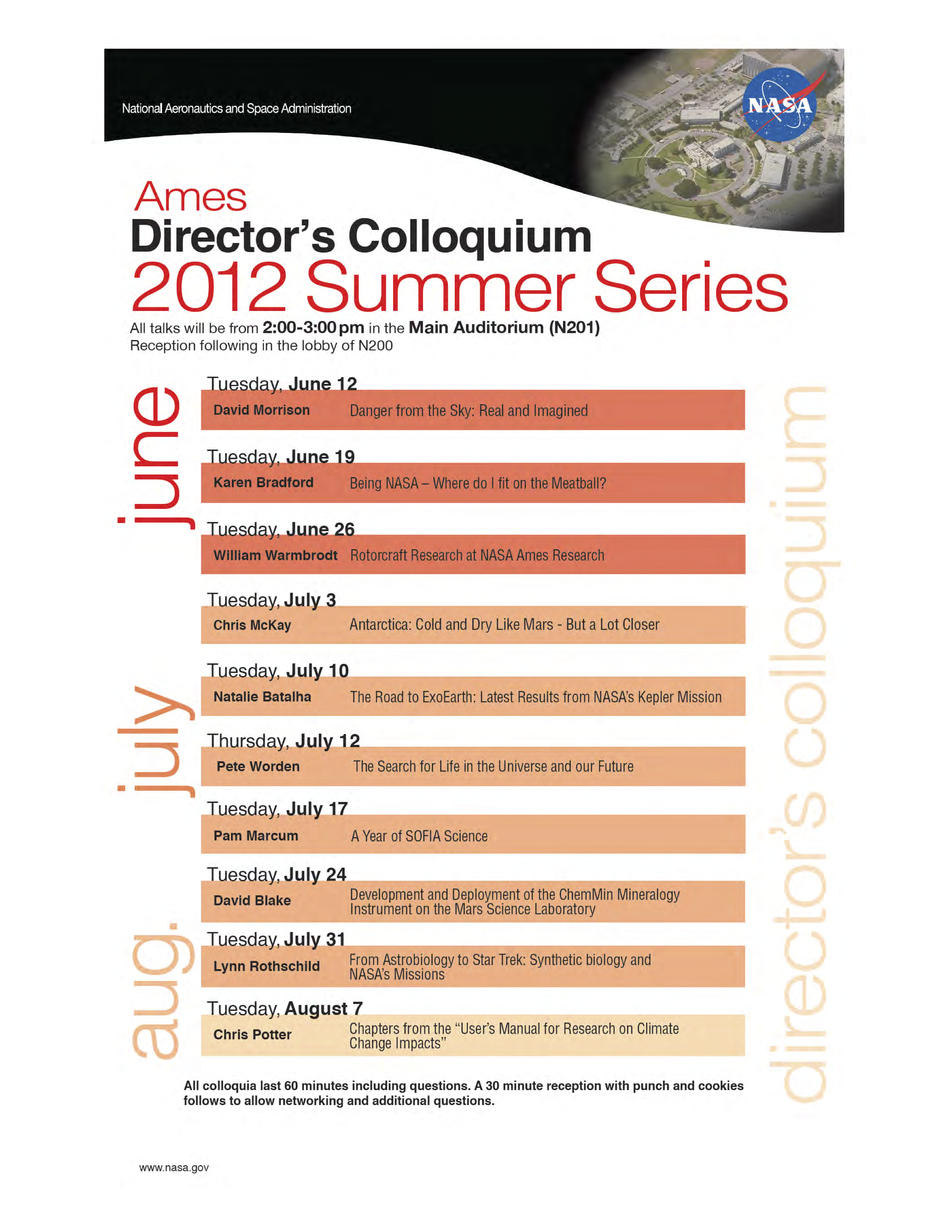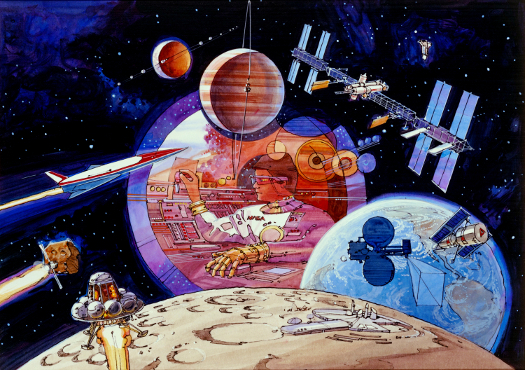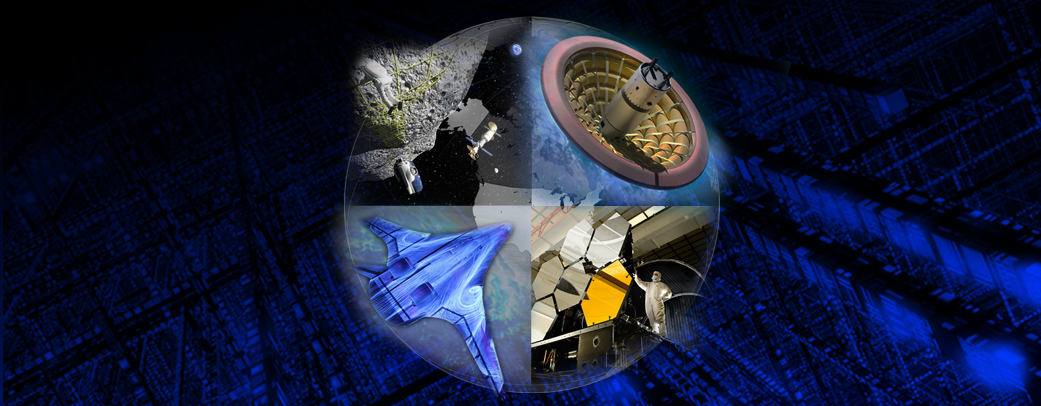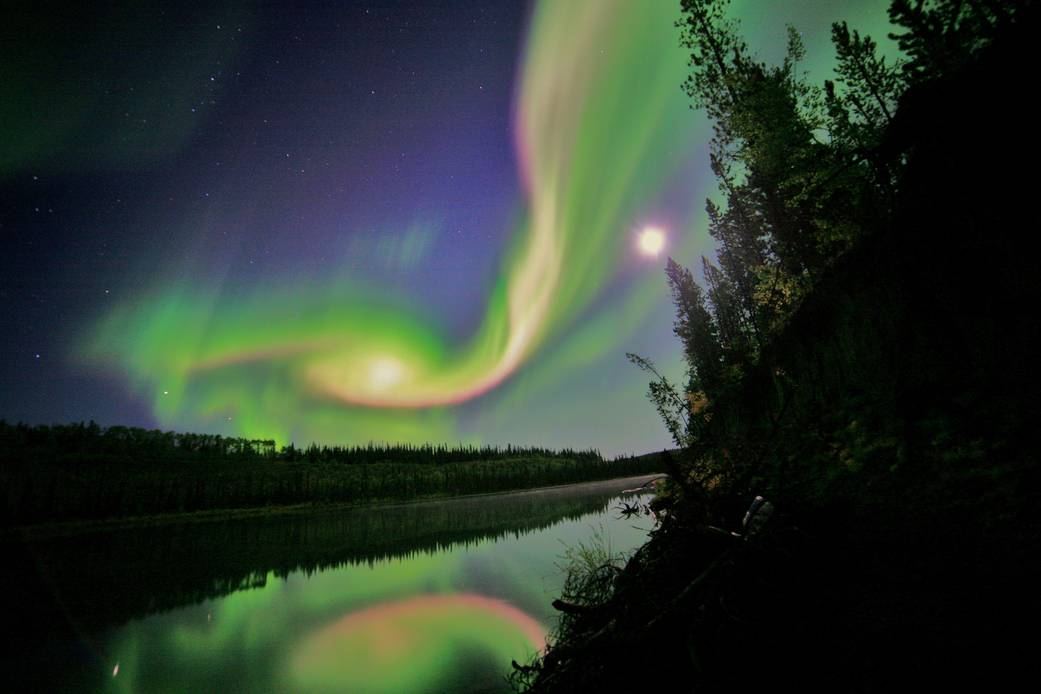2012 Summer Seminar Series
The Summer Series is a set of talks by subject leaders from around the globe. Each year, the Office of the Chief Scientist produces a platform for innovative discussion and inspiration to catalyze scientific progress, share ideas, and communicate new and exciting concepts. Many subjects are discussed in the Summer Series, including distinctive topics relevant to the Agency’s goals that are engaging for a research and technology center. The Summer Series is a broad forum that aims to bring new and exciting stories to both NASA employees and the public.
 |
Natalie Batalha
The Road to ExoEarth: Latest Results from NASA’s Kepler Mission
This was an opportunity to get an update on one of the coolest missions that NASA has ever launched.
Abstract: Humankind’s speculation about the existence of other worlds like our own turned into a veritable quest with the launch of NASA’s Kepler spacecraft in March 2009. The mission is designed to survey a slice of the Milky Way Galaxy to identify planets orbiting other stars. It looks for the telltale dimming of light that occurs when an orbiting planet passes in front of the star thereby casting a shadow into space. She gave an update on the latest results, as Kepler has now discovered more than 1,000 new planet candidates, nearly doubling its previously known count. Ten of these candidates are near-Earth-size and orbit in the habitable zone of their host star. Kepler is honing in on the answer to the question that drives the mission: are potentially habitable worlds abundant in our galaxy.
Biography: Dr. Natalie Batalha is a professor of physics and astronomy at San Jose State University and co-investigator on NASA’s Kepler Mission. She holds a bachelor’s in physics from the University of California (UC), Berkeley, and a doctorate in astrophysics from UC Santa Cruz. Dr. Batalha started her career as a stellar spectroscopist studying young, sun-like stars. After a post-doctoral fellowship in Rio de Janeiro, Brazil, Dr. Batalha returned to California. Inspired by the growing number of exoplanet discoveries, she joined the team led by William Borucki at NASA’s Ames Research Center working on transit photometry — an emerging technology for finding exoplanets. Thirteen years later, she stood poised with the Kepler team to make discoveries that humans, up to now, have left to the imagination and the realms of science fiction.
David Blake
Development and deployment of the CheMin Mineralogy Instrument on the Mars Science Laboratory
With its rover named Curiosity, Mars Science Laboratory mission is part of NASA’s Mars Exploration Program, a long-term effort of robotic exploration of the red planet, with the primary goal of determining the planet’s habitability.
Abstract: The past 15 years of Mars exploration – by landers, rovers and orbiting spacecraft – has yielded a treasure trove of knowledge about the Red Planet. Each successive mission has carried with it a more capable, refined and nuanced science payload, building on the discoveries of its predecessors. The Mars Science Laboratory rover Curiosity arrived at Gale Crater on Aug. 5th, 2012. Curiosity is the most sophisticated and capable rover yet and it provided us with new knowledge of Mars’ present climate and geology, and clues to its early habitability. “CheMin,” one of the two laboratory instruments aboard Curiosity, was developed at Ames and, for the first time, provided definitive mineralogy of soils and rocks on Mars.
Biography: David Blake received a B.S. in Biological Sciences from Stanford University in 1973. After graduation, he served as an unrestricted line officer in the US Navy until 1977. Blake attended graduate school at the University of Michigan, where he received an MS in Sedimentology in 1980 and a Ph.D. in Geology & Mineralogy in 1983. He came to Ames Research Center as a NRC postdoctoral fellow, and became a research scientist in the Exobiology Branch in 1989. Blake was the Exobiology Branch Chief from 2000-2004. He is the Principal Investigator of CheMin, a mineralogy instrument included in the payload of Mars Science Laboratory, which landed on Mars on August 5, 2012. In nearly 25 years at Ames, he has enjoyed studying astrophysical ices, interplanetary dust, carbonaceous chondrites and Mars meteorites, lunar soils and stratospheric soot, and designing spacecraft instruments.
Karen Bradford
Being NASA – Where do you fit on the meatball?
This was an opportunity to learn about what it is like to work at NASA from her perspective as Chief of Staff.
Abstract: This talk provided some insight into the key contributions and dynamics of the communities that make up the NASA “meatball”. Everyone has a part to play on the NASA Team. Everyone. Whether you are in Science, Technology or Mission Support, each person is an integral part of the NASA family. The meatball has been described as a ball of engineering wrapped in a thin veneer of Science. It is important to remember that just because you live in the thin veneer, it does not mean the rest of the meatball does not exist. The same goes for living in the ball of engineering/technology! For that matter, the red pulse and atomic energy of the mission support community is what gives the meatball life and is just as important as the rest of the community. Orienting where you fit on the meatball will provide insight and awareness into what it takes to be a part of the amazing NASA Team and what role you play in its success.
Biography: Karen C. Bradford is the Chief of Staff at NASA Ames Research Center, and has served as a civil servant for 24 years. Serving as Chief of Staff at NASA Ames includes a variety of complex and changing challenges that range from managing VIP visits, national and international, to administering various processes and interactions that are critical to the success of the Center and the Agency. Karen’s work for NASA began as Executive Assistant to Dr. Baruch Blumberg, Director, NASA Astrobiology Institute (NAI) where she planned, implemented and served as project lead for the first NAI Minority Institution Faculty Sabbatical. In 2005, Karen was selected as a member of the National Coalition of 100 Black Women, Silicon Valley Chapter. Karen often speaks or guest teaches at local parish organizations during the year, is an accomplished singer, plays piano and cantors most recently for St. Lucy Parish Church in Campbell, CA. She is a very proud mother of 5 and grandmother of 5.
Chris McKay
Antarctica: Cold and Dry Like Mars – But a Lot Closer
Dr. McKay is a world renowned planetary scientist and expert on Mars.
Abstract: Antarctica is the coldest, driest continent on Earth and is therefore an interesting analog for Mars. Over the years we have been studying three microbial ecosystems found in the dry valley regions of Antarctica: the endolithic algal and lichen layer inside porous sandstone rocks, microbial mats at the bottom of ice-covered lakes, and life in ice-cemented ground under dry permafrost at very high elevations. These studies suggest that early Mars could have been quite cold and still supported liquid water environments and life. The national and commercial programs that provide access to Antarctic provide interesting examples of how access to the Moon might develop.
Biography: Dr. Christopher P. McKay is a planetary scientist with the Space Science Division of NASA Ames. McKay received his Ph.D. in astrogeophysics from the University of Colorado in 1982, and has been a research scientist with the NASA Ames Research Center since that time. His current research focuses on the evolution of the solar system and the origin of life. He is also actively involved in planning for future Mars missions including human settlements. McKay has been involved with polar research since 1980, traveling to the Antarctic Dry Valleys, the Atacama Desert, the Arctic, and the Namib Desert to conduct research in these Mars-like environments. Dr. McKay is a recipient of the Urey Award from the Division of Planetary Sciences of the American Astronomical Society for his contributions.
Pamela Marcum
A Year of SOFIA Science
As Project Scientist for SOFIA, her primary responsibilities are to assure the scientific integrity of the mission and to provide advice and guidance to the SOFIA Program Office on scientific issues.
Abstract: Stratospheric Observatory for Infrared Astronomy (SOFIA), an airborne observatory optimized for conducting astrophysical investigations across the infrared-tosub-millimeter spectral range, is an international partnership between the U.S. and German space agencies. SOFIA’s maiden science flight occurred in November 2010, followed by hundreds of additional flight hours using three of the seven 1st-generation instruments. This first year of SOFIA science covered Solar System to extragalactic astrophysics, and demonstrated various observation modes including instrument team science, peer-reviewed observations by the community, and a target of opportunity that required coordination of heroic proportions! Her presentation will highlight major SOFIA discoveries, describe the idiosyncrasies of operating a flying observatory, and outline the expanding potential for new investigations as the full instrument complement is commissioned.
Biography: Dr. Pamela Marcum began her research career with the study of white dwarf stars while an undergraduate at the Florida Institute of Technology, where she graduated with a B.S. and M.S. in Space Sciences and Physics. Her research direction changed to extragalactic astronomy while in graduate school, where she worked on the near-IR and optical properties of ring galaxies and galaxy groups, and also participated in Hubble Space Telescope Wide-Field and Planetary Camera-2 Science Definition Team activities. After receiving a Ph.D. in Astronomy at the University of Wisconsin-Madison, Dr. Marcum became a postdoctoral research associate at the University of Virginia where, with fellow team members of the Ultraviolet Imaging Telescope at NASA Goddard, she worked on the first extensive ultraviolet imaging of local galaxies. Before joining NASA Ames in 2009, Dr. Marcum worked for over a decade as a professor in the Department of Physics & Astronomy at TCU in Fort Worth, TX. For three of those years, she was appointed at NASA headquarters in Washington, D.C., serving as the Program Scientist for the WISE and Kepler missions, and managing the UV/optical/IR portfolio of the Research & Analysis grants program.
David Morrison
Danger from the Sky: Real and Imagined
This was an opportunity to learn about asteroids and their threats to our planet from one of the leading experts in the field.
Abstract: Asteroids and comets occasionally strike the Earth with catastrophic consequences. The dinosaurs, who did not have a space program to detect and deflect such objects, paid the price. We can do better, and we have made a substantial start on an international planetary defense effort. Many in the public, however, are focused on imaginary dangers. Millions of people believed that a rogue planet called Nibiru was inbound and will “destroy the Earth” in December of 2012. Many people seem to be much more worried about phantom dangers than real ones, challenging us to better communicate the science of cosmic collisions.
Biography: David Morrison is Senior Scientist at the NASA Lunar Science Institute and also serves half-time as Director of the Carl Sagan Center for Study of Life in the Universe at the SETI Institute. For 20 years he has led in defining the asteroid impact threat. Now he also struggles against pseudoscience; he is the leading scientific critic of the 2012 doomsday hoax.
Chris Potter
User’s Manual for Research on Climate Change Impacts
Chris presented an up to date account of what we know about climate change in the context of research that is being carried out in the Earth Sciences Division.
Abstract: Global climate change has already had observable effects on Earth’s biosphere. Glaciers have shrunk, ice on rivers and lakes is breaking up earlier, plant and animal ranges have shifted, and trees are flowering sooner. Impacts that scientists had predicted in the past would result from global climate change are now occurring: loss of sea ice, accelerated sea level rise, and more intense heat waves. Most scientists have high confidence that global temperatures will continue to rise for decades to come, largely due to greenhouse gasses produced by human activities. Nonetheless, conclusive scientific studies of climate change impacts must be carried out over a time course of 50 to 100 years, while NASA’s longest and best satellite records for monitoring the Earth are only 20-30 years old. This presents NASA researchers with many pressing challenges to overcome in using Earth Observations for climate change impact detection. This presentation will address many of these challenges and present new images of ecosystem change already underway around the world.
Biography: Dr. Christopher Potter is a Senior Research Scientist in the Biospheric Science Branch at NASA Ames Research Center. He holds a Ph.D. degree in forest ecology from Emory University with specialties in remote sensing applications for forest and woodland ecosystems, and has published nearly 100 journal articles. Dr. Potter was named an Ames Fellow in 2007 and has received several other NASA research awards in his 20-year career at Ames Research Center.
Lynn Rothschild
From Astrobiology to Star Trek: Synthetic biology and NASA’s Missions
Lynn discussed some of the exciting work we are doing in synthetic biology at Ames and how it can possibly revolutionize space exploration.
Abstract: Synthetic biology the design and construction of new biological parts and systems and the redesign of existing ones for useful purposes has the potential to transform fields from pharmaceuticals to fuels. Our lab has focused on the potential ofsynthetic biology to revolutionize all three major parts of astrobiology: Where do we come from? Where are we going? and Are we alone? For the first and third, synthetic biology is allowing us to answer whether the evolutionary narrative that has played out on planet earth is likely to have been unique or universal. For example, in our lab we are re-evolving biotic functions using only the most thermodynamically stable amino acids in order to understand potential capabilities of an early organism with a limited repertoire of amino acids. In the future synthetic biology will play an increasing role in human activities both on earth, in fields as diverse as bio-mining, human health and the industrial production of novel bio-composites. Beyond earth, we will rely increasingly on biologically-provided life support, as we have throughout our evolutionary history. In order to do this, the field will build on two of the great contributions of astrobiology: studies of the origin of life and life in extreme environments. Imagine 4 billion years of evolution as a giant genetic hardware store, polish up your pipettemen, rev up your thermocycler, take aim with your gene gun and unleash your inner engineer!
Biography: Dr. Lynn Rothschild, is an evolutionary biologist/ astrobiologist at NASA Ames, and Professor at Stanford and Brown University, where she teaches Astrobiology and Space Exploration. She has broad training in biology, with degrees from Yale, Indiana University, and a Ph.D. from Brown University in Molecular and Cell Biology, and a love for protists and evolution. Since arriving at Ames in 1987, her research has focused on how life, particularly microbes, has evolved in the context of the physical environment, both here and potentially elsewhere, and how we might tap into “Nature’s toolbox” to advance the field of synthetic biology. Field sites range from Australia to Africa to the Andes, from the ocean to 100,000 feet on a balloon. In the last few years Rothschild has brought her expertise in extremeophiles and evolutionary biology to the field of synthetic biology, addressing on how synthetic biology can enhance NASA’s missions. For the last two years she has been the faculty advisor of the Brown-Stanford award-winning iGEM team. Rothschild is a Fellow of the Linnean Society of London, the California Academy of Sciences and the Explorers Club.
William Warmbrodt
Robocraft Research at NASA Ames Research
Dr. Warmbrodt described how unique technical expertise and national test facilities have made Ames a world’s leader in helicopter and advance rotary wing technology.
Abstract:
Since the days of the NACA, Ames Research Center has been a world’s leader in helicopter and advance rotary wing technology. Today, NASA Ames continues to develop the technology to improve aerodynamic efficiency and mission performance for existing helicopters and tilt rotor aircraft and to enable new vertical lift aircraft designs. Working jointly with the U.S Army Aeroflightdynamics Directorate (AFDD) and the U.S. Air Force Arnold Engineering Development Center, NASA Ames conducts scientific experimentation, numerical modeling, wind tunnel testing, and flight research in helicopters and advanced rotorcraft. The presentation covered recent technology developments in civilian and military vertical lift aircraft development with a focus on NASA Ames’ unique technical expertise and national test facilities, including the NASA Vertical Motion Simulator, the U.S. Air Force National Full-Scale Aerodynamics Complex, and the U.S. Army AFDD Flight Projects Office.
Biography:
William Warmbrodt received his BS, MS, and PhD degrees in engineering from the University of California at Los Angeles. He also holds a MS in management from Stanford. Dr. Warmbrodt is an expert on full- and small-scale experimental research into rotor dynamics and aerodynamics, and analytical research into rotor aeroelasticity, performance, loads, and controls. He has been Chief of the Aeromechanics Branch at Ames since 1985. Currently he manages over 20 full-time NASA scientists and engineers in rotorcraft and rotary wing analytical and experimental research in aeromechanics and flight controls. He has been involved in many aspects of rotary wing technology, including serving as Editor-in Chief (1986-1987) of the American Helicopter Society Journal.
Pete Worden
The Search for Life in the Universe and Our Future
Dr. S. Pete Worden spoke about Ames’ world-class effort in astrobiology and synthetic biology.
Abstract: As we continue to seek for evidence of life beyond Earth, two sources of new data come to the fore. The first is our search for places that could support life. Locations where liquids and sources of energy exist have been the focus of NASA’s recent efforts. We’ve found a number of such places in the solar system where these requirements might be met. Recently we’ve begun to identify numerous planets in other solar systems that could, in principle, have liquid water on their surfaces. A second new source of insight into our search for life comes from our own technology development. In particular, the emerging field of synthetic biology suggests that we ourselves and presumably extra terrestrial intelligence could engineer life to exist in much broader ranges of conditions that we find on the Earth’s surface. In this lecture I will discuss the status of these two developments and their implications for our search for life.
Biography: Dr. Simon P. Worden (Brig. Gen., USAF, ret.) is the center director at NASA Ames Research Center where he leads a staff of nearly 2500 civil servants and contractors, and oversees an annual budget of approximately $800 million providing the critical R&D support that makes NASA’s and the nation’s aeronautics and space missions possible. Prior to becoming Ames director, Dr. Worden was a Research Professor of Astronomy, Optical Sciences and Planetary Sciences at the University of Arizona where his primary research direction was the development of large space optics for national security and scientific purposes and near-earth asteroids. Additionally he worked on topics related to space exploration and solar-type activity in nearby stars. He is a recognized expert on space issues ‹ both civil and military. He has authored or coauthored more than 150 scientific technical papers in astrophysics, space sciences, and strategic studies. Moreover, he served as a scientific co-investigator for two NASA space science missions.































